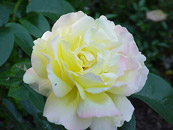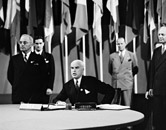While Americans grew Victory Gardens, a rose born in war-torn France but dedicated to peace grew in exile in a Pennsylvania nursery.
By Patrice Crowley
 The Peace rose, the most popular rose in the world, blossomed out of World War II. At first known simply as Number 3-35-40, the Peace rose was created by French hybridizer Francis Meilland of the Meilland rose-breeding family in Lyon. In 1935 he cross-pollinated two roses, but achieved mediocre results. He did not discard the resulting hybrid tea rose, however, and by 1936 the plant began to show promise, bearing lush green foliage and large ivory-yellow blooms tinged with pink.
The Peace rose, the most popular rose in the world, blossomed out of World War II. At first known simply as Number 3-35-40, the Peace rose was created by French hybridizer Francis Meilland of the Meilland rose-breeding family in Lyon. In 1935 he cross-pollinated two roses, but achieved mediocre results. He did not discard the resulting hybrid tea rose, however, and by 1936 the plant began to show promise, bearing lush green foliage and large ivory-yellow blooms tinged with pink.
Meilland introduced this rose to French gardeners in 1942, calling it Mme A. Meilland after his mother. In Germany it was known as Gloria Dei, and in Italy, Gioia. But World War II made Meilland’s aim to introduce it to the rest of the horticultural world increasingly unlikely. So, Meilland sent bud wood to the United States on one of the last planes out of his country.
In America, Robert Pyle of the Conard-Pyle Company in West Grove, Pennsylvania, propagated the bud wood and sent samples of the plant to the American Rose Society for review. When the Nazis left France, Pyle was able to inform Meilland that he would introduce the rose to the public at the war’s end. He decided to name the rose Peace in celebration of that event.
 Peace rose made its debut at the first rose show of the Pacific Rose Society of Pasadena, the city known for its annual Tournament of Roses Parade. At the ceremony on April 29, 1945, white doves were released to celebrate both the new rose and the impending fall of Berlin.
Peace rose made its debut at the first rose show of the Pacific Rose Society of Pasadena, the city known for its annual Tournament of Roses Parade. At the ceremony on April 29, 1945, white doves were released to celebrate both the new rose and the impending fall of Berlin.
With dark, glossy leaves and multi-petaled flowers up to five inches in diameter, the rose rapidly became the best-selling garden rose of all time. It won the 1946 All-America Rose Selections Award, the 1947 American Rose Society National Gold Medal Certificate, and the 1965 Gold Rose of the Hague. But perhaps its most significant claim to fame was its distribution to the delegates of the first United Nations meeting, in San Francisco in 1945. American Rose Society Secretary Ray Allen sent each of the delegates a rose with the note “We hope the Peace rose will influence men’s thoughts for everlasting world peace.”
Since then, Conard-Pyle estimates, between 30 and 40 million Peace plants have been grown, although some experts say that number is low. Even today tens of thousands of the plants are purchased annually for backyards, parks, and gardens. The rose has also been put in special municipal Peace gardens that nations around the world created to commemorate the 50th anniversary of the German surrender in World War II.
To bring your own garden some Peace and beauty, ask at your local garden center if the Peace rose is hardy enough for your area’s climate. The plant is disease resistant and hardy and grows to six feet. It needs at least six hours of full sun daily and thrives in well-drained, well-fertilized soil.


FOLLOW US »
